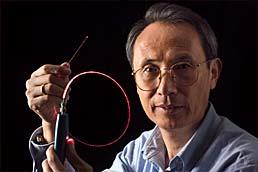Quantum Information Sciences

Xiao Tang of NIST's Information Technology Laboratory and colleagues conduct research on quantum communications over optical fiber channels.
Challenge
Since the early 20th century, we have known that the atomic, or quantum, realm works under vastly different rules than the world of our everyday experience. The ability to understand and exploit aspects of the quantum realm has led to many of the technological advances that defined the last century, such as lasers, MP3 players, and MRIs. Yet, the quantum realm holds still more surprises, and more possibilities.
One of the most exciting of these possibilities is the prospect of harnessing quantum phenomena to process information in ways that can be used to solve some of today's most intractable computing problems. Only in recent years have we developed some capacity to create and control quantum properties in the laboratory. However, many basic research questions remain to be answered before a fully functional quantum computer can be built.
Proposed NIST Program
Today, the United States is at the forefront in understanding and applying quantum principles to information systems, but other nations are making rapid progress. NIST is a world leader in quantum information science, compiling a record that includes many quantum "firsts" and three Nobel Prizes in Physics. It is developing new approaches to manipulating, controlling, and using quantum systems. NIST's role in this field is vital to creation of improved quantum materials for high performance quantum information processing systems and developing quantum devices for memory, communication, and processing.
To further the nation's progress in developing new quantum-based measurement techniques and information technologies, NIST proposes to:
Begin defining the class of problems that a general-purpose quantum computer can efficiently solve, and
Pursue applications to exploit quantum coherence and quantum entanglement for measurement capabilities exceeding classical limitations in sensitivity and accuracy.
Expected Impacts
Building on the research accomplishments supported by initiative funding in FY 2007 and FY 2009, the proposed program will enable NIST to:
Improve understanding of the power of a general purpose quantum computer to better guide both NIST's intramural program and the U.S. national program;
Begin to bridge the gap between fundamental quantum science and new technologies by developing some of the quantum components needed for realization of a quantum device and a quantum computer; and
Develop quantum information applications relevant to NIST's core mission and to the nation's fundamental measurement needs.

